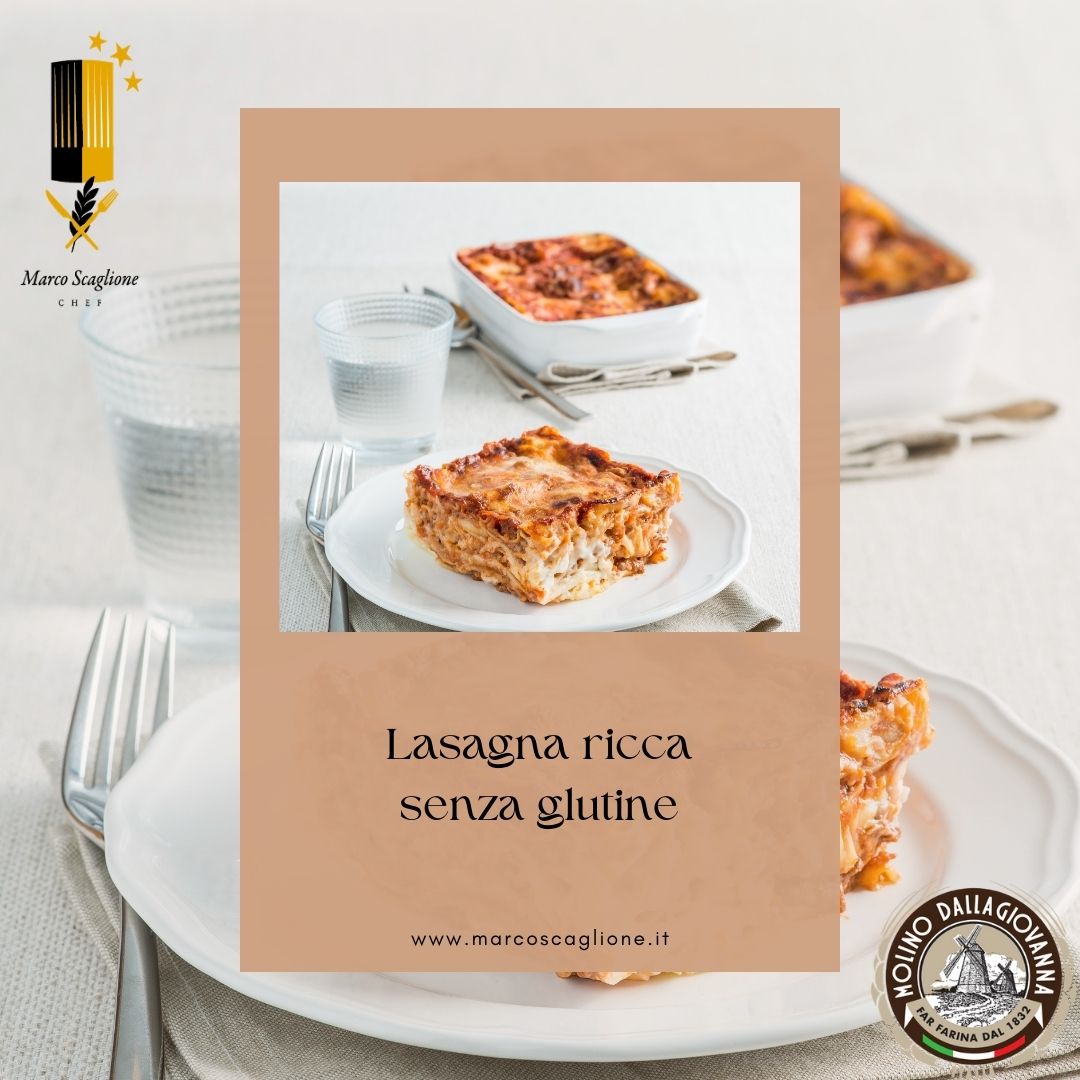
Marco Scaglione
My professional biography and my story are linked together they kept strong by a strap which is called passion. I'm lucky: I like my job, I enjoy it and it fills me with satisfaction.
It was born a new collaboration between Marco Scaglione and Aksum. Click on the logo and visit their site.
Rich gluten-free lasagna
Full list
Time: 2 ore
Difficulty: facile
The Italian dish that disputes its origins between Bologna and Naples, but which has its own version in each region.
Characteristics:
Lasagna is made up of alternating layers of egg pasta with a wide variety of toppings. The versions differ already in the choice of pastry which can be the classic egg pasta, or green, red or yellow if mixed into the basic dough with spices or vegetables.
History:
Already known by the Romans who with the terms “laganon” and “laganum” indicated a thin sheet of pasta obtained from a dough based on wheat flour, which was cooked in the oven or directly on the fire. Apicius, in particular, explicitly speaks of a “lagana” made up of thin sheets of pasta stuffed with meat and cooked in the oven. But it was simply a mess of pasta and meat mixed at random.
Notes:
There is an eternal challenge over lasagna between Naples and Bologna. Significant, then, is the fact that the **Italian Academy of Cuisine** has deposited at the Chamber of Commerce of Bologna (2003) the recipe for green lasagna alla bolognese, and not the “white” version. The latter are prepared with classic Bolognese ragù, Parmigiano Reggiano, béchamel, butter and green pasta dough prepared with spinach. While Neapolitan lasagna, a typical carnival dish, is prepared with Neapolitan ragù, meatballs, ricotta, provola, pecorino, extra virgin olive oil and pasta dough, strictly “white”.
Ingredients for 4 people:
300 g special Molino Dalla Giovanna for fresh pasta
3 whole eggs
2 egg yolks
40 g water
10 g extra virgin olive oil
8 g fine salt
For the ragù:
500 g finely minced beef pulp
250 g minced pork
2 celery stalks
1 carrot
1 yellow onion
1 glass of red wine
1l tomato puree
50 g tomato paste
2 bay leaves
extra virgin olive oil
fine salt
black peppercorns
For the béchamel sauce:
1l milk
35 g butter
35 g gluten-free very fine rice flour
fine salt
nutmeg
200 g parmesan
For the filling:
2 hard-boiled eggs
200 g mozzarella
Method:
Prepare the pasta. Mix the mix in a bowl and add the eggs and egg yolks to the center; combine everything with the salt, water, oil and work vigorously until you obtain a smooth mixture. Create a ball with it, cover it with cling film and let it rest in the refrigerator for 30 minutes.
Prepare the ragù. Trim and wash the celery; trim and peel the carrot, then blend it in a blender with the peeled onion and celery, until you obtain a fine and homogeneous mixture.
Brown the mixture in a large pan with 3 tablespoons of extra virgin olive oil for 5 minutes, stirring occasionally with a wooden spoon.
At this point add the beef pulp and the minced pork and cook for 10 minutes, stirring constantly with a spoon, so as to crumble the meat well. Wet with the wine, let it evaporate over a high flame, then add the bay leaf, the tomato puree and 1.2 dl of water, and cook over a low flame for about 2 hours, stirring occasionally.
20 minutes before the end of cooking, season with salt and pepper and remove from the heat.
Take the fresh pasta out of the fridge and roll it out with the pasta machine, bring it to a thickness of about 4 mm and create sheets, sprinkle with rice flour and leave to dry on a cutting board for about 1 hour.
Put a pot on to boil, bring it to the boil, season with salt, after the resting time, cook 2/3 sheets at a time, season with salt and cook the pasta for about 2 minutes. Drain in a bowl with cold water, when the pasta has cooled, dry in a cloth and set aside for the moment.
In the meantime, prepare the béchamel. Pour the milk into a pot, bring it almost to the boil and add a pinch of salt and a grating of nutmeg; in a second pot, melt the butter, add the gluten-free rice flour and mix it with a whisk; cook for 1 minute, so as to toast it and let the same flour cook, but without letting it brown.
Add the milk to the butter and rice flour mixture, pouring it in a thin stream, continuing to mix with a whisk and thickening the béchamel on the heat.
In the meantime, chop the hard-boiled eggs and mozzarella, set aside.
Coat a large baking tray with some of the béchamel and place a layer of gluten-free lasagna on top, cover with more béchamel and some of the ragù and complete with the parmesan, eggs and mozzarella. Create a new layer of pasta and proceed as indicated until the ingredients are finished, closing with the ragù and parmesan. Distribute the butter in flakes on the surface of the lasagna and finally cook in a hot oven at 180°C for about 30 minutes; once cooked, remove from the oven, leave to rest for 15 minutes and serve.
 English
English
 Italiano
Italiano
 Español
Español
 Francais
Francais



 Condividi su:
Condividi su:

